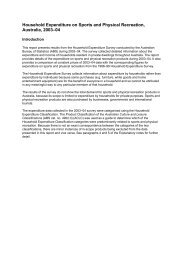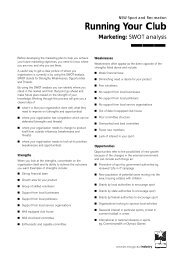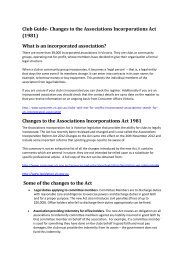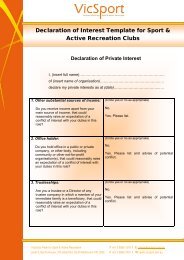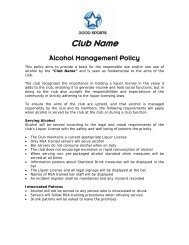Good Governance Tool Kit - VicSport
Good Governance Tool Kit - VicSport
Good Governance Tool Kit - VicSport
Create successful ePaper yourself
Turn your PDF publications into a flip-book with our unique Google optimized e-Paper software.
Supported by:introductionA strong sporting team has the right mix of skills and experience to perform at its peak. Talent identification andteam selection are the most influential factors on performance and ultimately the success or failure of any team.The Board of a sporting organisation is no different yet organisations rarely place the same importance on theselection and make up of their board. Boards that are diverse in gender, age and background and have the rightmix of skills and abilities function more effectively and are more successful in achieving the best outcomes forthe organisation.good governance & diversity frameworkResearch conducted by vicsport from July 2007 - June 2009 revealed a scope of recommendations andpotential strategies to improve governance practices and diversity on boards of State Sporting Associations(SSA’s). These recommendations and strategies recognise that individuals, organisations and the sport andactive recreation industry together play an important role in creating change and achieving significantprogress towards board diversity and good governance practices.These evidence based strategies form a <strong>Good</strong> <strong>Governance</strong> and Diversity Framework that identifies opportunitiesacross the three key areas.individualsorganisationsindustry•Pathways ontoboard positions•Skill assessment forposition selection•Managing work-life balance•Networking &relationship building•Mentoring•Understanding boardbehaviour & culture•Understanding boardroles & responsibilities•Overcoming “tokenism”•Confidence building•Review of boardstructure & purpose•Consideration of electionand appointment ofboard members•Implementation ofboard Induction•Board behaviour & culture•Board performanceincluding skills audit,assessment & evaluation•Consistent datacollection of boardcomposition of SSA’s•Skills bank of vacantboard positions•Showcase femalerole models•Development of resourcesto support individuals& organisations•Deliver mentoring,networking & professionaldevelopment opportunities forwomen•Promoting the benefitsof board diversity•Highlighting barriersand strategies for femaleboard participation2 good governance tool kit
Supported by:• Encouragement for Women to Apply – vicsport’s research also revealedthat generally females are more likely to apply for board positions whenencouraged and supported in this process. For boards that have historicallybeen male dominated it is recommended that the board actively seeks skilledfemale professionals.Click here for the vicsport <strong>Good</strong> <strong>Governance</strong>: Lack of Confidence Fact Sheet• Board Profiles – Including profiles of existing board members on your web siteis recommended so that potential applicants can consider where their attributesand skills would “fit” into the existing mix and to highlight existing role modelsfor other women if your board already has female directors.Click here for a Board Profile Template• Review of Constitution – The Board may consider a review of the constitution forthe inclusion of appointed positions to fill skill and diversity gaps if the board isfully elected.UK organisation, National Council for Voluntary Organisations (NCVO) also specifies a number of practicalguidelines for nonprofit organisations to adopt in recruiting and renewing their board. Whilst it may not berelevant or even practical for a volunteer based organisation to carry out each of the listed strategies below,these guidelines can act as a useful check list to assist boards in planning a successful election process thatis suitable for their organisation.• The board should have a strategy for its own renewal, with succession planningarrangements in place.• The Board may wish to delegate implementation of this strategy to asub-committee or panel.• The Board should consider setting maximum terms of office to ensure asteady renewal of trustees; these may be set out in standing orders or in theorganisations governance document.• Before new trustees are appointed, the Board should determine what newattributes and knowledge are needed, and write them down in the form of arole description, or role profile.• The Board should ensure that the recruitment process is open to all sectionsof the community and should consider open advertising and a range of otherrecruitment methods to attract a wide range of candidates.• Candidates should, where the organisation’s governing documents permit,be interviewed formally, and appointed on merit.• The Board should ensure that the procedures for joining and leaving theBoard are clearly understood.9 good governance tool kit
Supported by:2.2 consideration of possible barriers forboard participationPotential barriers to board participation should be considered so that the election and appointment processis fair and equitable and that board members are elected based on ability rather than popularity or profile.Barriers identified during the good governance project include:• Lack of role models – Due to the fact that the majority of sporting boards arepredominately male dominated there is a lack of role models for women to aspire toin leadership and governance positions. Your Board may wish to consider mentoringfor women and greater encouragement for women to apply for board positions.• Unconscious bias – Interview panels should be gender equal to combatunconscious bias in the interview and selection process.• Application process – Organisations need to ensure that the application processis clear and transparent. A comprehensive Board Election <strong>Kit</strong> should be readilyavailable.2.3 succession planningRecruiting board members that are representative and have appropriate skills and expertise is bothimportant and often very challenging for many organisations.The Board Succession Series by Our Community provides not-for-profit boards with a valuable step-by-stepguide to plan an election and appointment process.Part 1: Finding New Board membersPart 2: Recruiting New Board membersPart 3: Selecting the right Board membersPart 4: Checklist10 good governance tool kit
Supported by:3. board inductionintroductionA comprehensive introduction to the organisation and board operations allows new directors tobe properly informed, supported and welcomed to the board from the time of their appointment.vicsport’s <strong>Good</strong> <strong>Governance</strong> research indicated that a board induction process could strongly influencea new director’s experience and board involvement and was especially influential for females entering anall male board. The research found that new directors were far more likely to contribute to the boardsooner following a comprehensive board induction.The Board Induction process seeks to provide new board members with the necessary informationand training to:• Better understand the board and organisational objectives• History and current position of the organisation• Contribute effectively to board discussion and decision making• Make informed decisions• Understand their roles and responsibilities as a director• Get to know fellow directors• Create a more enjoyable and rewarding experience3.1 board induction policyYour organisation may wish to adopt a board induction policy which outlines the purpose and implementationof the board induction process. The policy template provides an outline of key board induction elementshowever the template should be adapted to suit the specific needs of your organisation.Click here for a Board Induction Policy Template3.2 board induction checklistTo support the Board Induction process an induction checklist is a useful tool to ensure that all proceduresoutlined in the induction policy have been carried out.Click here for a Board Induction Checklist Template3.3 board introduction letterAn introduction or welcome letter should be sent by the President to the new board member soon after theirappointment to the board. The letter formally welcomes the new director onto the board and outlines what theinduction process will entail.Click here for a Board Introduction Letter Template11 good governance tool kit
Supported by:3.3.1 board role descriptionAlong with an introduction letter, the new director should receive a role description and code of conduct toensure they have a clear understanding of their new role as director. This will allow them the opportunity toreview these documents and clarify any queries prior to commencing their new position.A Board Role Description is similar to that of a Job Description. It outlines the key roles of the board memberand should form the basis of all board operations and discussions.Click here for a Board Role Description Template3.3.2 board code of conductA board code of conduct clearly describes the expectations of board members specifically relating to thebehaviour, culture, values and ethical standards that are agreed to by the board.Click here for a Board Code of Conduct Template12 good governance tool kit
Supported by:4. board behaviour & cultureintroductionIt should not be surprising that when a group of individuals with different backgrounds, skill sets andpersonalities get together that challenges in board function and dynamics can occur. Boards need to investtime into constantly nurturing a positive board culture to prevent conflict amongst its members and to ensurethat they are best serving the interests of their members.“The Australian Sports Commission Governing Sport – The Role of the Board (ASC, 2005;17) identified that oneof the greatest challenges facing boards is the ability to achieve consensus and cohesion while at the same timeencouraging diversity and legitimate dissent.” To assist sporting organisations to address this issue the ASCoutlined a range of factors that contribute to the development of an effective board team.• The skills mix of the board is appropriate to its role and tasks.• There is agreement that the board will ‘speak with one voice’ about all policymatters when communicating with the CEO and the outside world.• There is a robust and productive partnership with the CEO in which both good andbad news is shared openly and in a timely fashion.• There is a positive and constructive boardroom culture in which all directors knowthat their contribution is valued.• There is a good balance between talking and listening. Board members are willingto suspend judgment until an issue is fully canvassed and all perspectives are aired.• The chairperson manages the meeting processes so that issues before the boardare adequately addressed. Agenda and time management facilitate appropriateattention to board issues.• Legitimate dissent and diversity are viewed as healthy components in boardroomdialogue and encouraged so that the full range of views, opinions and experienceare available to support board decisions.• The views of management are sought and valued.• Board members can ask tough questions without management becoming defensive.4.1 mentoring and supportBoard behavior and culture can be significantly enhanced by providing appropriate mentoring and support forboard members. If newly appointed directors are assigned a mentor they are more likely to feel welcomed intotheir position, included into group dynamics, have greater self confidence and feel better informed to contributeto discussion. Interviews conducted with female directors for the <strong>Good</strong> <strong>Governance</strong> Project supported thisand also revealed that a comprehensive induction process involving mentoring and support results in a morerewarding experience for directors.Click here for the vicsport <strong>Good</strong> <strong>Governance</strong>: Mentoring and Encouragement Fact Sheet.13 good governance tool kit
Supported by:4.2 leadership and the role of the chairFemale directors who were interviewed as part of vicsport’s <strong>Good</strong> <strong>Governance</strong> Project suggested that theChairperson can strongly influence the behaviour of directors and boardroom culture. The Chairpersonshould lead by example and can really “set the scene” for a boardroom culture that is respectful and inclusive.Board meetings should be managed by the Chair in a manner designed to encourage diversity of opinion,ensuring that all board members are given an opportunity to contribute to board discussion. This leadershipcan greatly enhance the experience for females sitting on male dominated boards.“The Australian Sports Commission Governing Sport – The Role of the Board (ASC, 2005;4-5) describesthat the chairperson is responsible for leadership of the board, ensuring its effectiveness in all aspects of itsgovernance role. The chairperson is pivotal in creating the conditions for overall board and individual boardmember effectiveness and ensures constructive relations between board members and staff.The chairperson’s role and responsibilities include:• Representing the board — the chairperson is usually the board’s representativeto outside parties, though this responsibility may be delegated as appropriate.• Setting the agenda and ensuring board members receive timely and clearinformation — the agenda should take full account of the issues and concernsof all board members. Agendas should be forward-looking and concentrate onstrategy, rather than focusing on management issues.• Managing board meetings — direct or control meetings to ensure that sufficienttime is allowed for discussion of agenda items and proper decision-makingtakes place.• Liaising with the chief executive officer — while the board has responsibilityas employer of the chief executive officer, the board is usually representedthrough the chairperson in managing the working relationship with the chiefexecutive officer.• Board member development and encouragement — taking the lead in inductingand developing individual board members, with a view to enhancing the board’soverall effectiveness as a team.• Performance assessment — ensuring that peer and self-assessments ofperformance are undertaken regularly for all members of the board, includingthe chairperson.The chairperson may delegate certain aspects of his or her authority but remains accountable for the actionof the delegate.The chairperson is bound by the board’s governance policies and decisions and thus hasno authority to alter, amend or ignore these. The position of chairperson does not create of itself a right toindependent decision taking. The chairperson may exercise those powers delegated to the position by theconstitution or board. It is useful to have a written document that details the decision making powers ofthe chairperson.”14 good governance tool kit
Supported by:4.3 inclusion & diversity trainingIt is important for all board members to be supportive of a process to improve board diversity for it to besuccessful. Demonstrating the benefits of board diversity through education and training may be a useful way tobuild commitment from board members and the organisation as a whole. Your board may choose to embark onformal diversity training or perhaps choose to introduce the idea by using case studies or including an agendaitems for discussion.Contact Our Community for information and resources to educate your board about the benefits of diversityand inclusiveness.4.4 self imposed targets and quotasDue to the low representation of women on boards the enforcement of quotas or self imposed targets has longbeen a topic of debate. In Norway, legislation relating to the minimum number of women on corporate boardswas introduced with levels of representation now reaching 45% since the laws were implemented in 2003.In the sporting industry, Hockey Australia is leading the way with their gender equity stance, which requireseach gender to represent at least 35% of the board.It is generally accepted that quotas can lead to an increase in representation of women on boards and possiblyact as a conduit for cultural change in organisations by:• Allowing women to make an impact at board level by affording them anopportunity they may not otherwise have been afforded,• Increasing the awareness of the benefits of gender diversity on boards,• Is an opportunity to break down barriers and improve confidence of womento apply for board positions.In many cases quotas are a result of frustration and imposed as a last resort for progress to occur due to thefollowing concerns.• Women only being brought onto boards because women’s voices wereunderrepresented and as a compensatory gesture (tokenism)• Quotas being viewed as ceilings• Positions may no longer be afforded to the best possible candidate.Click here to read the vicsport Women on Boards fact sheet on Quotas.4.5 board values & teamworkThe board should establish an agreed set of values and beliefs that guide board behaviour and decision making.These values and beliefs should be clearly outlined in a Code of Conduct to ensure that the reputation oforganisation is managed, protected and enhanced.Click here for a Code of Conduct Template.15 good governance tool kit
Supported by:4.6 effective meetings & decision making“As mentioned by Fishel, D. in The book of the Board: Effective <strong>Governance</strong> for non-profit organisations(2003:”141) Meetings can make or break a board. Ill-directed or ill-prepared meetings can sap the energy andmotivation of board members, whereas purposeful and well organised meetings can build the organisationssense of direction and motivate the board members and staff involved.”The decision to commit your time to a board position is one that requires strong consideration. The researchundertaken for the vicsport <strong>Good</strong> <strong>Governance</strong> project revealed some of the main motivations for directorsjoining a board. These included;• wanting to contribute something valuable back to their sport,• to feel as though they are making a worthwhile contribution to their community and• to have the opportunity to apply and develop specific skills.The main reason cited in our <strong>Good</strong> <strong>Governance</strong> Research for females not applying for board positions was dueto family and/or work commitments. For this reason it is important for meeting to run effectively as lengthy andunproductive board meetings can frustrate board members and act as a deterrent to potential applicants.“The Australian Sports Commission, Governing Sport – The Role of the Board (2005:20-21) state in theirguidelines for the conduct of board meetings that:• Board meetings should focus on governance matters affecting the control anddirection of the organisation, such as policy-making and review, financial healthof the organisation, strategic thinking and progress towards Key Result Areas,and legal compliance, rather than on administrative and operational matters.• Board meetings should reflect an appropriate apportionment of focus betweencompliance with formal requirements, for example, monitoring financialperformance, and monitoring overall achievements of Key Result Areasand engaging in strategic thinking.• The board meeting is an ideal forum for the board to engage in strategic thinkingin order to ensure the ongoing relevance and appropriateness of its strategic planand Key Result Areas. The meeting should adopt a future building on past learning.• Board meetings should be managed in a manner designed to encourage diversityof opinion, ensuring input from all board members as appropriate withoutprejudicing effective and efficient decision-making.“4.6.1 board meeting agenda templateA good meeting agenda will serve as a guide to participants, making the meeting more efficient and productiveby encouraging the group to think out what needs to be accomplished.To help develop an agenda for a purposeful meeting, consider the following:• What decisions need to be made?• Are there matters coming out of the sub-committees that require a board decision?• Are all items accompanied by clear recommendations for action?16 good governance tool kit
Supported by:• What items require noting?• Put the most urgent items at the beginning of the agenda where the board membersare ‘fresh’ and in case the meeting has to break with unfinished business.• It can be a good idea to put time allocations next to items, more or less dependingon their importance. Don’t be obsessed with clockwatching, but you want to beable to give the important things the time they need, and you can’t do that ifyou’ve frittered away the meeting time on trivialities.• Don’t make the agenda too long. A meeting should not run for more than two hours.After that people are tired and unproductive.Click here for a Meeting Agenda Template4.6.2 board calendarA Board Calendar should be mapped out at the start of each year and serves two important functions.Firstly, it provides board members with a clear outline of their commitments for the upcoming year.Eg: How often does the board meet and for how long? Secondly, it is a useful planning checklist toensure that the board is carrying out all of its key roles including financial, legal, planning andrisk management responsibilities.Click here for a Board Calendar Template4.6.3 features for an ideal board meetingThe importance of making board meetings focused and productive and the influence of board meetings inshaping board member behavior should not be underestimated. In reality board meetings are likely to geta little ‘off track’ from time to time and boards may find it necessary to reflect on current meeting practicesin order to re-focus. The following points outline some of the key features of a productive and well managedboard meeting that can be used as a quick audit with your board.• Board meetings start and finish on time.• The agenda is distributed to board members with sufficient time to read andrespond if necessary.• Everyone thoroughly reads the meeting agenda and board papers prior tothe meeting.• The Chair ensures that the agenda is followed and that meetings run on time.• The Chair invites and includes all members to participate in discussion.• Members are respectful of the Chairs authority.• Debates are robust and conducted in a courteous manner.• Member’s contributions are relevant and concise focusing on strategic issuesrather than operational matters.• Members are happy to accept collective decisions even when they have beenvoted against.17 good governance tool kit
Supported by:5. board performance & and evaluationintroductionThe link between a high performing board and the successful performance of an organisation is widelyaccepted. In a sporting context, a well functioning board will almost certainly have a positive influence onday-to-day operations as well as the performances of individual directors, staff, members and volunteers.A regular evaluation process to obtain feedback on the collective performance of the board as well asthe performance of individual directors is necessary for effective board function, ongoing developmentand improvement.5.1 board performance health checkPrior to commencing a thorough evaluation process your board may wish to consider some key componentsof good board performance. Some of the components of a well functioning board are outlined below and canbe used as a quick “health check” by your board.• The Board operates to a strategic plan,• The Board is the correct size to allow for effective decision making,• There is a diverse mix of skills and experiences,• The election process delivers a pool of diverse Board members requiredfor effective governance,• A rotation policy has been implemented with defined terms of appointment,• The Board implements practices that allows for the inclusion of womenand other minority groups on the Board,• The Board has an effective induction program in place for new Board members,• The Board has established a Code of Conduct and agreed to a set of valuesand positive behaviours to guide board members,• The division of roles and the functions of the Board and staff is understood,respected and observed by all Board members,• Ethical, legal and financial responsibilities are understood,• Conflicts of interest are declared and dealt with appropriately,• Meetings are well organised and make effective use of time,• A regular cycle of evaluation is undertaken to obtain feedbackand improve performance,• Appropriate risk management policies and processes are in place.18 good governance tool kit
Supported by:5.2 benefits of board performance evaluationThere are a number of benefits to board performance that result from taking part in a performance evaluationprocess, some of which may include:• Improved leadership,• Greater clarity of roles and responsibilities,• Improved teamwork,• Greater accountability,• Better decision making,• Improved communication and• More efficient board operations.5.3 board performance and evaluation policyThe Board Performance and Evaluation Policy should clearly describe the purpose and process of assessingboard performance. It is important that organisations introduce an evaluation process that suits the needsand interests of the organisation. If your organisation is introducing a board evaluation for the first timeyou may like to introduce a simple process and add complexity to the process in the future.Surveys provide a convenient and confidential way to measure Board Performance. vicsport recommendsthat the collective performance of the board as well as the performance of individual directors should beassessed during the evaluation.It is also recommended that boards use an independent facilitator to ensure that the process is carried outindependently and confidentially.Click here for a Board Evaluation Policy Template5.4 performance evaluation and individualself-assessmentAs part of the <strong>Good</strong> <strong>Governance</strong> Project vicsport developed a board performance evaluation surveyand individual self-assessment tool.An evaluation which assesses the overall performance of the board is useful to identify areas of strengthand highlight particular areas that require improvement from the board.The Individual self-assessment tool allows directors to reflect on their own personal skills, attributesand contribution to the board and identify possible development opportunities. The results are also usedto undertake a skills audit. Knowledge of the current skill set of the board may be used to inform futureboard recruitment and communication with members.It is strongly recommended that an external facilitator conducts the evaluation process and providesprofessional assessment of the results. The Board Evaluation and Self-Assessment survey which wasdeveloped as part of the <strong>Good</strong> <strong>Governance</strong> Project is included in this tool kit as an example only.Click here for a Board Performance Evaluation and Individual Self-Assessment – Example Only19 good governance tool kit
Supported by:5.5 skill gap analysisA Skill Gap Analysis allows the board to have a clearer understanding of:• The relevant skills, qualifications and experience required to meet board goals• Current gaps in skills and diversity• Current strengths so that director’s skills can be utilised to their full potential• Areas for professional development• Information required to communicate with members and inform futurerecruitment strategiesTo have an accurate understanding of current board skills, and to accurately complete the skill gap analysis,it is recommended that the board first undertakes a skills audit.Click here for a Skill Gap Analysis Template20 good governance tool kit
LEVEL 3 SPORTS HOUSE375 ALBERT RD SOUTH MELBOURNE 3205TELEPHONE 03 9926 1376FACSIMILE 03 9696 7931EMAIL admin@vicsport.asn.auwww.vicsport.asn.auFollow us on:www.facebook.com/VictorianSportsIndustrywww.youtube.com/vicsportTVwww.twitter.com/vicsportAU



